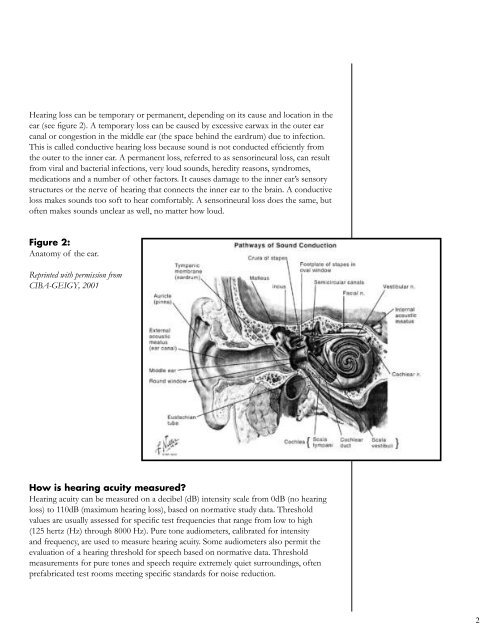Healthy Hearing Program - Special Olympics
Healthy Hearing Program - Special Olympics
Healthy Hearing Program - Special Olympics
Create successful ePaper yourself
Turn your PDF publications into a flip-book with our unique Google optimized e-Paper software.
<strong>Hearing</strong> loss can be temporary or permanent, depending on its cause and location in the<br />
ear (see figure 2). A temporary loss can be caused by excessive earwax in the outer ear<br />
canal or congestion in the middle ear (the space behind the eardrum) due to infection.<br />
This is called conductive hearing loss because sound is not conducted efficiently from<br />
the outer to the inner ear. A permanent loss, referred to as sensorineural loss, can result<br />
from viral and bacterial infections, very loud sounds, heredity reasons, syndromes,<br />
medications and a number of other factors. It causes damage to the inner ear’s sensory<br />
structures or the nerve of hearing that connects the inner ear to the brain. A conductive<br />
loss makes sounds too soft to hear comfortably. A sensorineural loss does the same, but<br />
often makes sounds unclear as well, no matter how loud.<br />
Figure 2:<br />
Anatomy of the ear.<br />
Reprinted with permission from<br />
CIBA-GEIGY, 2001<br />
How is hearing acuity measured?<br />
<strong>Hearing</strong> acuity can be measured on a decibel (dB) intensity scale from 0dB (no hearing<br />
loss) to 110dB (maximum hearing loss), based on normative study data. Threshold<br />
values are usually assessed for specific test frequencies that range from low to high<br />
(125 hertz (Hz) through 8000 Hz). Pure tone audiometers, calibrated for intensity<br />
and frequency, are used to measure hearing acuity. Some audiometers also permit the<br />
evaluation of a hearing threshold for speech based on normative data. Threshold<br />
measurements for pure tones and speech require extremely quiet surroundings, often<br />
prefabricated test rooms meeting specific standards for noise reduction.<br />
2

















